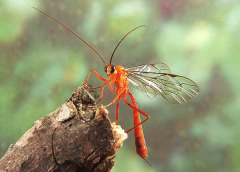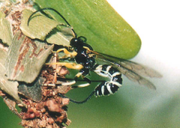Ichneumon wasp
|
|
| Ichneumon wasps | ||||||||||||
|---|---|---|---|---|---|---|---|---|---|---|---|---|
 Ichneumon wasp (body size about 20 mm) | ||||||||||||
| Scientific classification | ||||||||||||
| ||||||||||||
| Families | ||||||||||||
The Ichneumon wasps are insects classified in the parasitica group of the suborder Apocrita within the Order Hymenoptera. Sometimes incorrectly called Ichneumon flies, they are solitary insects, and most are parasitoids - the larvae feeding on or in another insect which finally dies. As with all hymenopterans, Ichneumons are closely related to ants and bees.
The superfamily Ichneumonoidea (consisting of two families: the Ichneumonidae and the Braconidae) has been estimated to contain well over 80,000 different species. Some members use many different insects as a host, others are very specific in host choice. Various Ichneumons are used successfully as biological control agents in controlling pests such as flies or beetles.

Ichneumon species are highly diverse - ranging from 1/8-inch to 5 inches long. Most are slender, with many species having an extremely long ovipositor for laying eggs. The female finds a host and lays an egg on, near, or inside the host's body. Upon hatching, the larval Ichneumon feeds either externally or internally, killing the host when they themselves are ready to pupate.
Members of the (usually larger) Ichneumonidae are distinguished from the Braconidae by observing wing structures.
References
- research.amnh.org (http://research.amnh.org/entomology/social_insects/training/hymintro.html) as of 2004-01-15.
External links
- An interesting account (http://www.conservation.state.mo.us/conmag/2002/05/30.htm) of an observer's encounter with Ichneumons.
- http://eny3005.ifas.ufl.edu/lab1/Hymenoptera/Ichneumonid.htm
- http://www.inhs.uiuc.edu/chf/outreach/good/card22.htmnl:Sluipwesp

